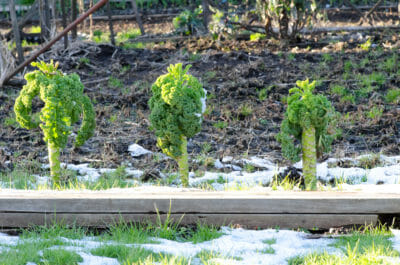[ad_1]
There are many ways to extend the growing season through the winter in cold temperate climates. This can be done by using cold frames, greenhouses, row covers, and raised beds, as well as mulching heavily and starting plants indoors. Perhaps one of the easiest ways to extend the season, however, is to grow a diversity of cold-hardy plants. Cold-hardy plants can allow you to begin harvests earlier in the spring while continuing to yield later into the fall and even through winter. Below is a sampling of some favorites, as well as some lesser-known cold-hardy vegetables.
Kale And Collards (Brassica Oleracea Acephala)
Certain varieties of kale, such as Red Russian, and Sea Kale may produce well into the winter, especially if protected by cold frames or other covers. Some may even survive the winter in areas as cold as zone 5, such as the perennial Sea Kale (Crambe maritima). This type of Kale is actually outside of the Brassica oleracea species of plants which includes other vegetables like kale, collards, cabbage, broccoli, and brussels sprouts. Mulch heavily and kale will stick around longer into the cold season, as with most plants.
Swiss Chard (Beta Vulgaris Cicla)
Although a heavy frost will kill chard, they will still produce well into the late fall in colder climates. If covered, chard may even last into the winter. On very rare occasions, swiss chard can make it all the way through, even in zone 5 or warmer.
Beets (Beta Vulgaris Conditiva)
Even after the beet greens die off above ground, you will still be able to harvest the beet itself, often well into the winter. Beets are related to chard and their greens are equally as delicious.
Cabbage (Brassica Oleracea Capitata)
Cabbage comes in many different varieties and is another excellent green that will last into the depths of the fall. There are even perennial varieties such as Walking Stick Cabbage. Perennial varieties don’t have the large cabbage head that is characteristic of more popular types of annual cabbage.
Good King Henry (Chenopodium Bonus-Henricus)
This spinach relative is another perennial green that lasts into the fall in even the coldest climates, and it will also emerge early in the spring. Mulch heavily and it should survive in as cold as zone 4 climates. The cooked young leaves are best and must be eaten soon after harvest since they wilt. The seeds can also be eaten once soaked in water overnight and rinsed, though they are a little small and time-consuming to harvest.
Remineralize Your Garden This Fall With All Natural Minerals From The Sea.
Perennial Onions (Allium Species)
There are a few varieties of perennial onions that last well into the fall in the coldest of climates, including Egyptian Walking Onion and Perennial Bunching Onion. These plants are commonly grown for their onion greens, but the bulbs can also be eaten. The bulbs may be harvested throughout the year, even when the aboveground greens die back.
Musk Mallow (Malva Moschata)
Musk Mallow is another perennial green that produces late into the year and comes up relatively early in the spring. The young leaves have a mild flavor and are best as one component of a multi-green salad. There are other varieties of mallow that are perennial as well. This variety is known to be one of the best flavored. The flowers and seeds are also edible, and the plant is hardy to at least zone 3.
Sunroot (Helianthus Tuberosus).
A vigorous perennial root crop growing to 10 feet tall, the flavor of the tuber improves after frost. Some say they are best eaten in their first year, though they will continue to produce and spread as a perennial for many years. Care should be taken to cook them well, and they shouldn’t be eaten in large quantity at first since they may cause gas. They are similar to beans in this way until your body grows accustomed to them.
Radicchio / Italian Chicory (Cichorium Intybus)
These perennials have edible leaves and roots. The leaves are a little bitter and are often blanched by excluding light while they are growing, making a sweeter, milder flavored green. Cook the roots like you would parsnips. The roots also make an excellent (caffeine-free) coffee substitute when roasted and powdered.
Perennial Yam (Dioscorea Batatas)
Grown commonly in Japan and other parts of Asia as food, this vine root crop cultivates well in cold temperate regions. This crop can be harvested well into the winter, or early in the spring (until the ground freezes or when it thaws). It is best grown in deep, sandy soil, where it will produce a much larger root than in more dense soils (up to 3 feet long!). Cook the yam before eating, either by baking or boiling, similar to a regular yam. It is not very flavorful but is an excellent addition to soups and will readily absorb added flavors. The vine also produces small “aerial tubers” which are little yam berries. These tubers can also be cooked and eaten or used to propagate more plants.
These are but a small sampling of the many cold-hardy vegetables that you can grow in colder climates. Many perennials are great crops to try for cold-hardiness. Cold-hardy perennials, will often produce longer into the year and come up earlier in the spring. Consider constructing cold frames or a passive solar greenhouse to extend your season even further. This will potentially making it last through the entire winter.
What are your favorite cold-hardy vegetables? Please feel free to share in the comments below!
[ad_2]
Source link
Get more stuff like this
in your inbox
Don't Be Left Unprepared
Thank you for subscribing.
Something went wrong.




